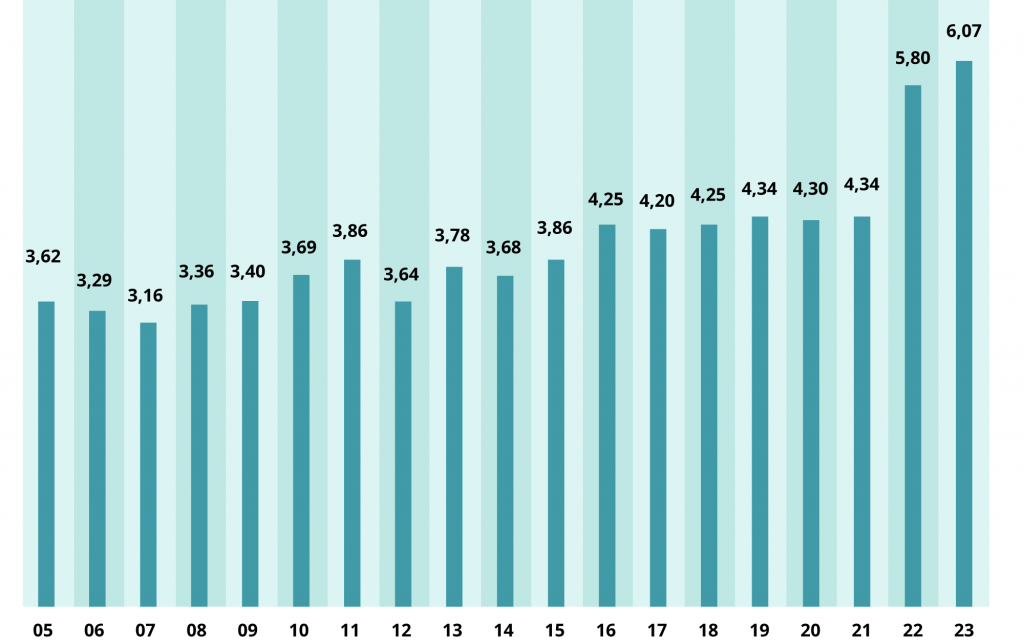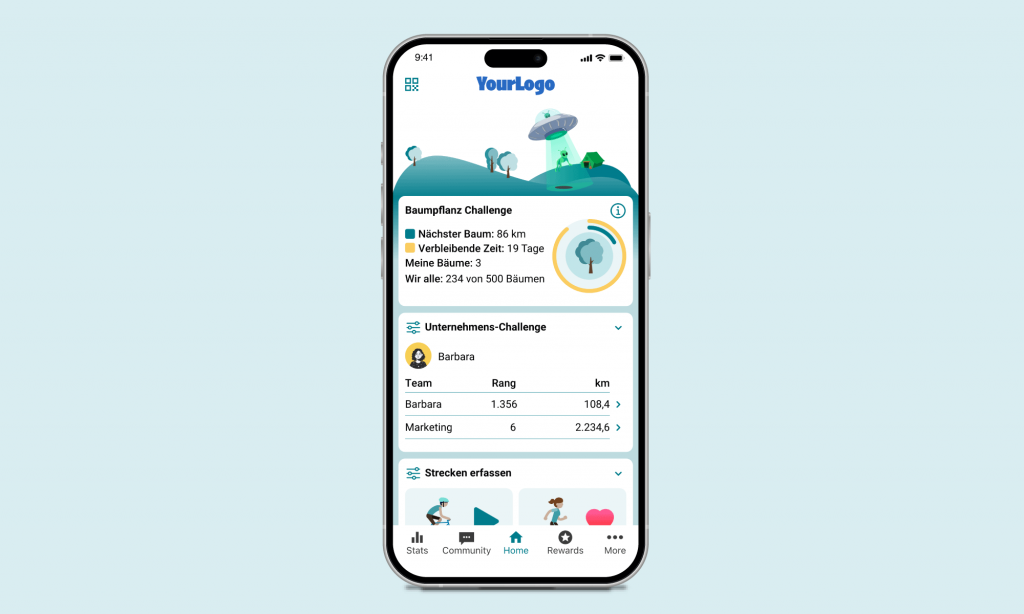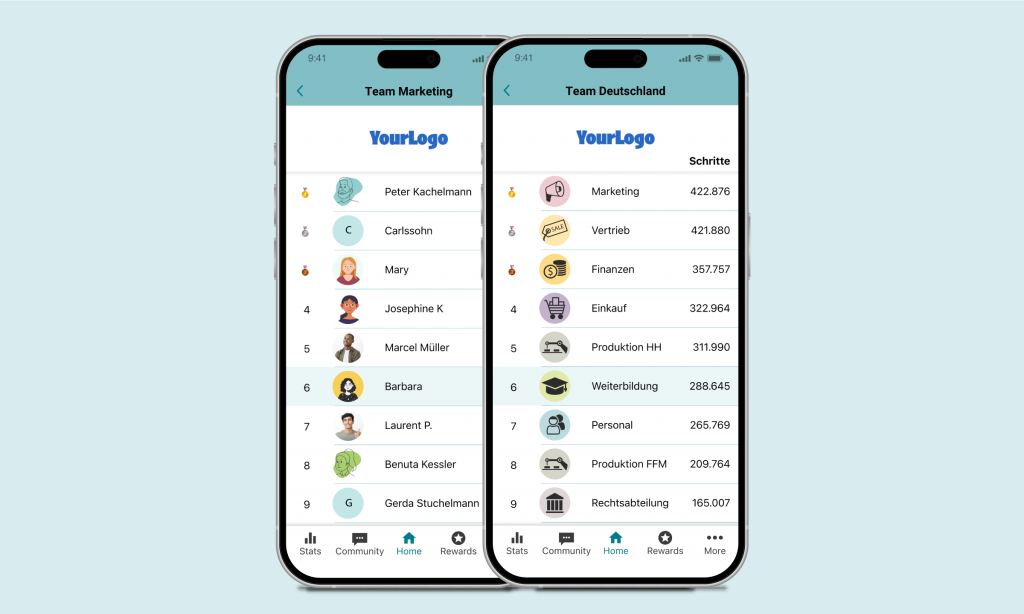
Health promotion in the workplace is not only a question of individual well-being, but also a decisive factor for the productivity and success of a company.
Occupational wellbeing is a key aspect of modern corporate management that aims to actively support and improve the health of employees. Promoting health in the workplace can have a positive impact on the entire company in various ways – from increasing motivating employees to reducing sickness rates and improving corporate culture.
Workplace health promotion more important than ever before:
Gallup Engagement Index 2023 – The emotional commitment of German employees will collapse in 2023. The number of internal resignations is as high as it was last in 2012, costing the German economy between 132.6 and 167.2 billion euros in lost productivity. Only 25% of German employees are completely satisfied with their direct manager. Almost half (45%) of German employees are either actively looking for a new job or are open to new challenges.
Definition of workplace health promotion
Health promotion (often abbreviated as WHP) encompasses all measures and strategies aimed at encouraging people to adopt a healthier lifestyle and making the conditions in which they live and work conducive to good health. It specializes in the context of the workplace and offers specific measures to improve the well-being of the workforce.
We will explain not only what WHP means exactly and how it differs from occupational health management (OHM), but also why, although there is no legal obligation to offer WHP measures, there are numerous reasons why companies should nevertheless invest in the health of their employees. We will also show the specific benefits for employers and employees and how to develop an effective OHM concept. Finally, we will present the Changers Fit app, an innovative solution that makes it easier to start a healthier lifestyle through low-threshold offers such as step challenges and at the same time strengthens team spirit and the working atmosphere.
This article will not only provide basic information on WHP, but also practical examples and suggestions for companies wishing to optimize their health promotion measures.
What is workplace health promotion (WHP)?
Workplace health promotion is a specific area within workplace health management. Together with occupational integration management and occupational health and safety, it forms the three pillars of occupational health management. Workplace health promotion focuses on holistic concepts and measures aimed at improving the health of employees, preventing illness and promoting a healthy work-life balance.
The three pillars of workplace health promotion (WHP)
| OSH Occupational Safety and Health | OWM Occupational integration management | OHP Occupational health promotion |
| • Prevention healthy and safe working • Risk assessment • Workplace inspections • Occupational health care • Training / Instruction | • Works agreement • Initial and follow-up meetings | • Exercise • NutritionHealth literacy • Stress management • Dealing with conflicts • Further education/Training • Healthy leadership |
Workplace health promotion is part of a company’s broader health promotion strategy. WHP includes various activities and programs specifically designed to support both physical and mental well-being in the workplace. This includes measures that make the work environment healthier, such as ergonomic workplace design and stress management programs, as well as initiatives that promote healthy lifestyles, such as nutritional advice and physical activity programs.
The implementation of occupational health measures enables companies not only to improve the health and well-being of their employees, but also to increase their performance and productivity in the long term. This leads to a win-win situation for employers and employees, with a healthy workforce being essential for the long-term success of the company.
Difference between occupational health management and workplace health promotion
Occupational health management (OHM) and workplace health promotion (WHP) are two concepts that are often used in the context of workplace health promotion, but have different focuses and approaches.
Definition of occupational health management (OHM)
Occupational health management is a comprehensive and systematic approach that aims to promote and maintain the health, well-being and performance of a company’s employees. OHM integrates all processes, structures and measures into the management of a company. The aim is to create working conditions that promote health and ensure a high quality of work. It includes not only the promotion of health and the prevention of illness, but also the integration of topics such as occupational safety, sickness absence management and psychosocial risk management. Find an overview of the top corporate health providers.
Definition of workplace health promotion (WHP)
orkplace health promotion is a sub-discipline of occupational health management and focuses specifically on measures that improve the health of employees directly in the workplace. It aims to prevent illness, improve health and increase the general well-being of the workforce. WHP includes specific programs and activities such as fitness offers, nutritional advice, stress management seminars and measures to promote a healthy work-life balance. We have compiled 100 workplace health promotion measures for your company.
Specific objectives and methods
While occupational health management offers a holistic framework that encompasses all aspects of the working environment, workplace health promotion focuses more on concrete, practical measures aimed at directly improving the health and well-being of employees. Occupational health management is strategic and long-term, integrated into the company’s overall strategy and takes into account the interactions between working conditions, organizational structures and individual behaviour. On the other hand, it is often project-oriented and focuses on specific health promotion and prevention measures.
In summary, occupational health management forms the organizational framework within which workplace health promotion acts as one of several pillars to specifically promote and improve health in the workplace. Both approaches are essential for sustainable health management in companies and complement each other in order to increase the health of the workforce and the productivity of the company.
Legal basis and voluntary measures in workplace health promotion
In Germany, there is no legal obligation for companies to offer workplace health promotion (WHP). While the Occupational Health and Safety Act (ArbSchG) obliges companies to take general measures to safeguard and improve the health of employees in the workplace, this does not go so far as to make it mandatory to implement specific WHP measures. The decision to implement health promotion programs is therefore left to the discretion of the company.
TIP: Statutory health insurance companies are obliged to support workplace health promotion. This is why many companies take advantage of this opportunity and rely on the help of health insurance companies when planning and implementing occupational health and workplace health promotion (WHP) measures. The health insurance funds not only offer financial support, but also provide concrete assistance in the planning and implementation of health promotion measures.
Use the advantages of voluntary health promotion:
Numerous scientific studies indicate that voluntary health promotion programs bring significant benefits for companies and their employees. These programs help to increase job satisfaction, strengthen employee loyalty and improve overall productivity. In addition, the figures on the current sickness rate show that health promotion should not be a “nice to have” for companies.
Average Sick Leave (%) of Members of the Statutory Health Insurance (GKV) in Germany from 2005 to 2023

Source: Federal Ministry of Health – Average sickness rate (%) of members of statutory health insurance (SHI) in Germany from 2005 to 2023
1. Workplace health promotion (WHP) leads to a significant increase in productivity
Research has shown that healthy employees tend to be more productive. A study published in the “Journal of Occupational and Environmental Medicine” shows that programs that promote health awareness can lead to a reduction in absenteeism and increased work performance. The World Health Organization (WHO) estimates that every dollar invested in health promotion can return up to $4 in saved healthcare costs and increased productivity.
2. Workplace health programs significantly improve employee satisfaction
Occupational wellbeing programs significantly improve employee morale. Employees who perceive that their employer is investing in their well-being feel valued and are more motivated. This positive perception not only improves individual commitment, but also the general working atmosphere. Studies, such as those conducted by the American Psychological Association, show that job satisfaction is closely linked to health promotion measures.
3. Health promotion in the company reduces medical costs
Through preventative measures, companies can significantly reduce the costs associated with illness. Programs aimed at preventing diseases such as cardiovascular disease and diabetes have proven to be particularly cost-effective by reducing long-term healthcare spending.
4. Workplace health promotion leads to a positive corporate culture:
Health-promoting measures strengthen the corporate culture and make the company more attractive to potential and current employees. In its study, the Organization for Economic Co-Operation and Development (OECD) states that a health-conscious corporate culture not only increases employee loyalty, but also strengthens employer branding.
Overall, workplace health promotion measures enable companies not only to promote the health and well-being of their employees, but also to achieve substantial financial benefits. This makes the voluntary implementation of workplace health promotion programs a strategically smart investment in the future of the company and its workforce.
The many positive effects of exercise on health have been proven in numerous studies.
The study by Hans-Christian Miko et al. impressively demonstrates the many positive effects of regular physical activity on health. The results show that exercise makes a significant contribution to promoting health across the entire lifespan. Specifically, positive effects on overall mortality, cancer, cardiovascular health, musculoskeletal health, metabolic health and neurocognitive health are highlighted.
- Cardiovascular health: Improvement of cardiovascular fitness, reduction of the risk of cardiovascular disease.
- Musculoskeletal health: strengthens bones, muscles and joints, reduces the risk of musculoskeletal disorders.
- Metabolic health: Positive effects on metabolic health, such as reducing the risk of type 2 diabetes.
- Neurocognitive health: Promotion of cognitive functions and improvement of neurocognitive health.
The study also emphasizes the importance of endurance-oriented movements and strength training, which should be specifically adapted to maximize individual health benefits.
oiuzAnother study led by Prof. Dr. med. Julia Dratva examines the benefits of workplace exercise programs that are carried out during working hours. Funded by the Swiss Federal Office of Public Health, this study sheds light on how such measures can not only improve the physical and mental health of employees, but also significantly increase their productivity. The influence on is particularly emphasized:
- Cardiovascular fitness: Increase in fitness levels, measured by improved cardiovascular tests.
- Muscle strength: Increase in muscle strength, especially in areas stressed by work such as the back and shoulders.
- Pain reduction: Decrease in reported pain among participants, particularly in the neck and shoulder area.
- Job satisfaction: Improvement in general satisfaction and reduction in sick days.
Advantages of occupational health promotion for companies and employees
Workplace health promotion (WHP) is much more than just a tool for preventive healthcare – it offers companies and employees numerous benefits that go beyond physical well-being. Targeted measures can not only improve the health and quality of life of employees, but also strengthen commitment, productivity and corporate culture in the long term. Below you will find an overview of the key benefits.
1. Increasing motivation through identification with the company.
2. Strengthening the employer brand in the competition for talent.
3. Cost reduction through reduced sick leave.
4. Improved quality of work and productivity.
5. Strengthening team spirit through group activities.
6. Promotion of the corporate culture.
7. Improved employee performance.
8. Increased employee loyalty.
9. Improved working atmosphere.
Advantages for the employees
1. Health improvement.
2. Easier access to health checks.
3. Better working conditions.
4. Minimizing the risk of health problems.
5. Improved quality of life.
6. More effective management of stress.
7. Increased job satisfaction and motivation.
8. More appreciation from the employer.
9. Access to fitness offers.
10. Improved sense of community.
Steps for developing an occupational health concept, planning and implementation
The successful implementation of corporate wellness promotion (WHP) in the company can be facilitated by a systematic approach. Here is a concise, clear checklist that shows how employers can effectively plan and implement WHP measures:
1. Clarify need for action
- Carry out an analysis of the current situation: Record the current state of health and working conditions of employees.
- Evaluation and concretization: Evaluate the results of the as-is analysis in order to identify specific need for action.
2. Develop options for action
- Define objectives: Determine which specific goals are to be achieved through the occupational health promotion measures.
- Clarify implementation options: Check what resources and capacities are available for implementation.
3. Involve the workforce
- Informing the workforce: Inform all employees about the planned measures.
- Integration of employees: Actively involve employees from all levels in planning and implementation.
4. Define responsibilities
- Designate contact persons: Define clear responsibilities within the company.
- Steering group: A steering group that monitors and manages the project can be useful.
5. Find cooperation partners
- Use networks: Cooperate with company neighborhoods, social insurance providers and other service providers to create synergies.
6. Implement measure
- Ensure accessibility: Ensure that all employees have easy access to health promotion measures.
- Role model function of the management level: Encourage managers to act as role models for health-conscious behavior.
- Communication: Regularly communicate the progress and offers of the corporate wellness program.
7. Record the effect of the measure
- Carry out evaluation: Use quantitative and qualitative instruments for target/actual comparisons.
- Obtain feedback: Obtain feedback from employees on the effectiveness of the measures.
8. Recognize further development potential
- Analyze effects: Investigate whether there are unexpected positive effects.
- Adaptation to needs: Regularly adapt existing measures to the current needs of employees.
Workplace health promotion measures list according to the setting approach conditions and behavior
Measures Setting – Approach Conditions & Behavior
| Category | Behavior-Oriented Measures | Condition-Oriented Measures |
| Nutrition | Nutrition courses, nutritional counseling | Healthy canteen food |
| Exercise / Ergonomics | Back exercise courses, walking | Health-promoting workplace design |
| Stress Management | Relaxation courses, stress management training | Healthy employee management |
| Addiction Prevention | Courses for smoking cessation | Smoke-free company, improvement of the work climate (mobbing, employee management) |
| Organizational Structure | Training in the area of organization and health | Establishment of health circles, structural measures for health promotion |
| Job Design | Training in the area of job design | Job change, flexible working hours |
| Corporate Culture Changers.com 2024 | Management training | Mission statement development, transparent communication, management competence |
The setting approach in workplace health promotion focuses on integrating health promotion into day-to-day processes at the workplace, taking into account both behavioral and situational prevention measures. Behavioral prevention aims to improve the individual health behavior of employees, while relationship prevention optimizes the work environment and conditions to support health-promoting behaviors. Here are some examples of measures in both categories:
Behavioral preventive measures
1. Promotion of physical activity
- Introduction of break activities such as guided stretching exercises or short walks together.
- Provision of company fitness subscriptions or cooperation with local fitness studios.
- Organization of internal company sporting events such as running groups or cycling challenges.
2. Nutrition
- Offering healthy snacks and meals in the canteen or by setting out fruit bowls.
- Training courses and workshops on healthy nutrition and its importance for performance.
- Introduction of nutritional advice by specialists directly at the workplace.
3. Mindfulness and stress management
- Carrying out regular mindfulness and relaxation training, such as guided meditations.
- Establishment of quiet rooms that can be used for relaxation during working hours.
- Offers to improve mental health, such as workshops on stress management.
4. Addiction prevention
- Provision of information materials and workshops to raise awareness of the risks of addictive behavior.
- Support for employees struggling with addiction problems through confidential counseling services.
- Promotion of non-smoking programs and support in quitting smoking.
Did you know that, according to the Gallup study, almost 20% of employees in Germany have resigned from their jobs? This means not giving up the employment relationship by resigning, but reducing work performance by refusing to show initiative and commitment to an extent as if the employee were no longer employed by their employer.
Relational preventive measures
1. Workplace design
- Ergonomic adaptation of workstations to prevent postural damage and promote a healthy working posture.
- Introduction of flexible workplace concepts that encourage movement and changes in posture.
- Optimization of lighting and air quality in workspaces.
2. Working time models
- Introduction of flexitime arrangements to enable employees to start and finish work more flexibly.
- Offer part-time models or job sharing to avoid overload and enable a better work-life balance.
- Implementation of working models that support home office and teleworking.
3. Corporate health promoting policies
- Development of a company policy that prioritizes health and well-being in the workplace.
- Creating a culture of openness in which health problems can be addressed without fear of stigmatization.
- Implementation of measures to create a safe and healthy working environment.
These measures should be seen as an integral part of the corporate strategy, which aims to promote both the individual health of employees and the productivity of the company. Through the combined application of behavioral and behavioral prevention approaches, a sustainable and effective occupational wellbeing concept can be developed that significantly improves health and well-being in the workplace.
Digital tools for health promotion
Occupational wellbeing has had to face new challenges, particularly due to the decentralization of workplaces. The trend towards spreading the workforce across different cities, countries and continents has been further intensified by the developments surrounding COVID-19. Many companies now describe themselves as remote-friendly, and some are even embracing a remote-first culture. This means that traditional office hours, when the entire workforce is onsite, are a thing of the past.
This is why new digital tools are now needed to reach employees everywhere, regardless of whether they work in the company or from home. Changers Fit App, for example, offers playful team competitions with low-threshold participation motivation in the areas of health promotion, employee motivation and climate protection.

Gamification, prize draws and a link between the challenges and tree planting or fundraising campaigns ensure more movement and team cohesion in 13 languages.
Easily digitize your workplace health promotion with the Changers Fit app
This is an ideal area of application for digital workplace health promotion. Employees can be reached and supported with health-promoting resources both in the office, on business trips and when working from home using digital health promotion tools.
The digital possibilities are diverse and constantly growing. Online training, 1:1 coaching or team challenges for workplace are just some of the options available.
Particularly popular are step challenges, which many companies use to emphasize the importance of exercise in everyday life and strengthen team culture at the same time. These and other innovative digital offerings can be perfectly integrated using tools such as the Changers Fit app to comprehensively promote the health of the team.

Step challenges are a classic in digital exercise motivation. In the Changers Fit app, you can set up to four team leaderboards for branches, departments or freely selectable teams, for example.
Please find more information about the Changers Fit app in your company.
30 examples of measures for workplace health promotion
Below you will find 30 more examples of occupational wellbeing measures that companies can implement to promote the health and well-being of their employees:
Physical health and fitness
1. Ergonomic workplace design
Adaptation of office equipment to prevent postural problems.
2. Company fitness programs
Subsidized gym memberships or setting up a company gym.
3. Health days
Organization of health days in your company |https://changers.com/blog/health-and-wellness-fair/| with a focus on health checks and wellness activities
4. Exercise breaks
Regular, guided short exercise sessions during working hours.
5. Company sports teams
Promotion of team sports such as soccer, volleyball or running groups.
6. Bicycle leasing offers
Support for leasing bicycles for the commute to work. Support the acceptance of the bike leasing offer with a motivating bike challenge.
7. Staircase competitions
Create incentives to use the stairs instead of the elevator. This will make your company’s step challenge a success.
Nutrition
8. Healthy canteen
Offering balanced and nutritious meals in the company canteen.
9. Fruit baskets
Provision of fresh fruit in work areas.
10. Nutrition workshops
Educational offers on healthy eating and practical cooking demonstrations.
11. Water stations
Accessible water dispensers to promote hydration.
Mental health
12. Stress management seminars
Workshops to learn techniques for coping with stress.
13. Meditation and relaxation courses
Courses such as yoga or progressive muscle relaxation.
14 Psychological counseling
Access to psychological counseling at the workplace or via external service providers.
15. Resilience training
Courses to strengthen mental resilience.
16. Mindfulness programs
Courses and apps to promote mindfulness and presence in everyday life.
Workplace culture and environment
17. Flexible working hours
Options for flexible working hours to improve work-life balance.
18. Home office options
Regulations that enable working from home.
19. Communication training
Improving communication skills within the team.
20. Team building events
Events and activities to promote team spirit.
21. Feedback culture
Establishment of a system for regular and constructive feedback.
Addiction prevention
22. Non-smoking programs
Support and incentives for employees who want to stop smoking.
23. Alcohol prevention seminars
Information about the risks of alcohol consumption.
24. Drug education
Information events on the prevention of drug abuse.
Health management and monitoring
25. Regular health checks
Offer health checks at the workplace.
26. Vaccination campaigns
Organization of flu vaccinations and other relevant vaccinations.
27. First aid training courses
Regular first aid courses for employees.
28. Health portals and apps
Providing digital resources for health monitoring and promotion.
Special offers
29. Company kindergarten
Provision of childcare facilities to support working parents.
30. Commuter support
Offers such as job tickets for public transportation or subsidies for commuters.
Do you have any questions? Talk to us!
We look forward to getting to know you and exploring the potential of the Changers Fit app for your company together with you.
Your contact person
Daniela Schiffer
E-Mail: d.schiffer@changers.com
Phone 0172 367 40 38


